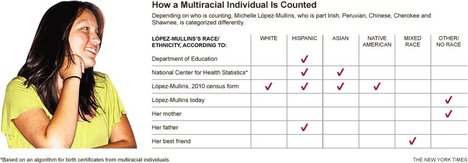 Source of graph: online version of the NYT article quoted and cited below.
Source of graph: online version of the NYT article quoted and cited below.
(p. A1) The federal Department of Education would categorize Michelle López-Mullins — a university student who is of Peruvian, Chinese, Irish, Shawnee and Cherokee descent — as “Hispanic.” But the National Center for Health Statistics, the government agency that tracks data on births and deaths, would pronounce her “Asian” and “Hispanic.” And what does Ms. López-Mullins’s birth certificate from the State of Maryland say? It doesn’t mention her race.
Ms. López-Mullins, 20, usually marks “other” on surveys these days, but when she filled out a census form last year, she chose Asian, Hispanic, Native American and white.
The chameleon-like quality of Ms. López-Mullins’s racial and ethnic identification might seem trivial except that statistics on ethnicity and race are used for many important purposes. These include assessing disparities in health, education, employment and housing, enforcing civil rights protections, and deciding who might qualify for special consideration as members of underrepresented minority groups.
But when it comes to keeping racial statistics, the nation is in transition, moving, often without uniformity, from the old “mark one (p. A17) box” limit to allowing citizens to check as many boxes as their backgrounds demand. Changes in how Americans are counted by race and ethnicity are meant to improve the precision with which the nation’s growing diversity is gauged: the number of mixed-race Americans, for example, is rising rapidly, largely because of increases in immigration and intermarriage in the past two decades. (One in seven new marriages is now interracial or interethnic.)
In the process, however, a measurement problem has emerged. Despite the federal government’s setting standards more than a decade ago, data on race and ethnicity are being collected and aggregated in an assortment of ways. The lack of uniformity is making comparison and analysis extremely difficult across fields and across time.
For the full story, see:
SUSAN SAULNY. “Race Remixed; In Multiracial Nation, Many Ways to Tally Can Throw Off Some Numbers.” The New York Times, First Section (Thurs., February 10, 2011): A1 & A17.
(Note: the online version of the story is dated February 9, 2011 and has the title “Race Remixed; Counting by Race Can Throw Off Some Numbers.”)

